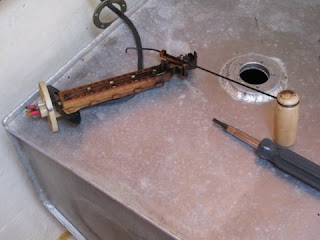We arrive in St. Augustine on May 30, staying at the very nice St. Augustine Municipal Marina. A very powerful current runs through the river there, so be careful if you're docking during the high current times. We took the afternoon to clean up and determine what we needed to do to check in to the US customs.
On May 31, we go to the Jacksonville Customs and Border Patrol office to check in and then off to the airport to send two crew home, do provisioning, and then back to the airport to pick up one new crewmember. Since we're convinced that it is the pump, which is on its way, there was no engine work planned. I went to the ship's store as everyone else was storing provisions and found that the pump had arrived! Overnight service that actually delivered! Everyone on LUX was happy to see the pump and the end of our engine problems. We had collected a list of boat bling, er, supplies, that we wanted, so we took advantage of our rental car to make a trip to West Marine. Upon return to LUX, we couldn't find a parking place anywhere around the marina, so we looked up an alternate restaurant, The Reef, which is a nice restaurant on one of the barrier islands. By the time we had dinner and returned, there were parking spaces available.
Experiment 4: First thing in the morning of June 1, Mike installed the pump. We anxiously awaited the first test. To our great disappointment, it ran even worse than before! The pump was not the problem!!! I was continuing to work on some electronics while Mike was working on the engine, because only one of us can really be working on the engine at a time. On one of Mike's experiments with the new pump, the engine would not start. What the hell?! All we heard was the solenoid clicking. The starter motor wouldn't turn over. Harumph!
 |
| We're spending a lot of time in this position! |
We grabbed an alligator clip lead and tried hot-wiring the starter, with no success. [I always take clip leads on boat trips; they are invaluable for any electrical work on board. Just get the really good ones that are made of 16ga wire or better with good alligator clips on each end.] The port engine is the one that previously had heat exchanger problems, which seeped salt water down the side of the engine. Out comes the socket set and the starter is quickly removed. Using the clip leads, we verify that the solenoid is good and that the starter motor runs. The various rust spots are cleaned up, the electrical connections are cleaned, and everything is reassembled. The engine now starts again. One problem after another. What next?
Mike is running out of things to try and is starting to repeat tests. Actually, we repeated a number of tests because while under way, we didn't have anything better to do and it made us feel better to do something rather than just sit there and stare at the engine. Repeating those same tests again is getting silly, we aren't getting any different results or any additional data to help diagnose what's happening. To paraphrase Einstein: Insanity is repeating the same thing over and over and expecting different results. We are certainly bordering on insanity with this problem.
So I decide to take a break from electronics and do a few experiments, thinking that perhaps another approach will yield some different data. One of the things that we've been doing is working the manual priming pump lever that's on the side of the fuel pump. It is supposed to be used to prime the fuel path from the filter to the high pressure pump. It doesn't seem to be working very well, because we're not getting a good flow of fuel to the secondary (2 micron) filter. We demonstrate to ourselves that the pump does indeed have good pumping action by running the starter to watch the fuel get pumped out at the secondary filter. The Jabsco hand pump also verifies that we can pull fuel through the system.
Experiment 5: We connect the output of the bulb hand pump to the filter input and make sure that we can pump fuel through to the secondary filter. We tighten the fuel connection and try it. It runs like it should!!?
So we let it run, to verify that it is reliable. There's a weird whine, which neither Mike nor I can identify. It isn't obvious when our heads are in the engine compartment, but it is clear when standing at least 10 ft away from the engine compartment, a place where we've rarely been when it is running. We let the engine run, just to make sure that the problem is solved. I check dock lines for when the tide changes. On my way back aboard with a port-side tie, I notice that there is no cooling water coming out of the exhaust! Quick, stop the engine!
To Be Continued...
















